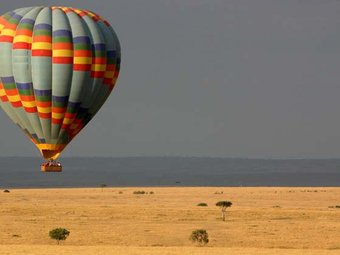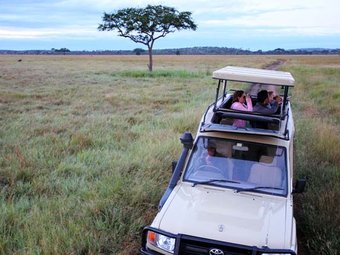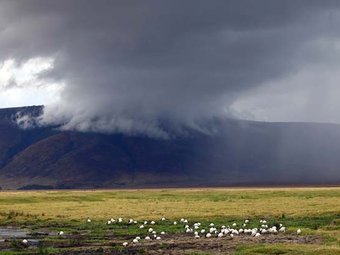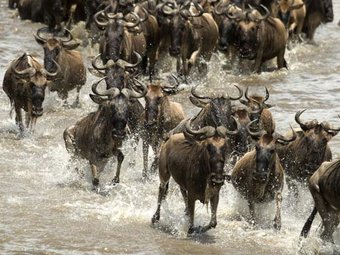Elephant Walk Safari
10 days—Elephant Walk Safari
$5000-10000 USD
pp
Safari summary
Wildlife viewing in Kenya: Nairobi National Park, Amboseli National Park, Tsavo East National Park
Types of Transportation: Land Cruiser, Bush Plane
Active Options Available: Walking Safaris
About this tour
| Tour type | Custom, tailor-made, private | |
| Main focus | Game drives | |
| Activity level | Easy activity | |
| Best months | January, February, June, July, August, September, October, November, December | |
| Countries | ||
| Parks |
Fine details
Safari highlights
- Cultural visits—orphanages, markets, schools
Itinerary
Day 1
Day 1 Travel day International flight
Day 2
Nairobi
Day 2 Ole Sereni Hotel Nairobi Pickup at Nairobi International Airport by our Deeper Africa driver, Lydia Mwanga, after clearing customs. Lydia will have a sign with your name on it. She will transport you to the Ole Sereni Hotel. Ole Sereni Hotel sits at the edge of Nariobi National Park. The Sheldrick Animal Orphanage is within the park’s perimeter. It is common to view wildlife from the room windows and the dining room. An outdoor patio makes it even easier. Overnight at Ole Sereni Hotel. Swimming pool available.
Day 3
Tsavo
Day 3 Ole Sereni Hotel Nairobi Lydia will pick you up this morning to take you to the Sheldrick Animal Orphanage. You’ll have a front row for the public viewing of the young elephants. The orphanage adopts juvenile elephants who have lost their mothers, often due to ivory poaching. Ivory wars are raging in our East African ecosystems and a baby elephant does not survive without a mother. The orphans live together, play together, and learn together. Elephants are emotionally sensitive and this bonding is a crucial step toward healing emotional wounds. The orphanage’s human caretakers are equally inspiring, serving as nursemaids, playmates, and teachers. We like to think of them as “elephant whisperers.” Each elephant keeper sleeps with a different elephant each night to prevent it from getting too attached to a particular keeper. The essence of an elephant family are doting caregivers, including the mother, but also branching out to include sisters, cousins, aunts, and grandmothers. Emotional bonds are crucial to survival in elephant society and Sheldrick seeks to raise the elephants in states that mirror maternal care in the wild. By age two, the orphans are moved to two holding centers in Tsavo National Park for the next phase in relocating them into the wild. Elephants that you will meet during the public viewing are less than two years of age. Sheldrick's program is a cutting edge experiment in cross species empathy that only the worst extremes of our species could have necessitated. Deeper Africa adopts an orphan on behalf of each Elephant Walk guest. After your viewing Lydia will be taking you out to lunch at Tamambo, a modern African brasserie that prides itself on friendly attentive service and delicious food. Lydia will swing by the Giraffe Center so you can feed the tame giraffes and learn a bit more about these amazing creatures. If interested Lydia can take you shopping at some of our favorite spots in Karen: Kazuri Beads; Utamaduni, House of Treasures, or Matt Bronze. We’ll have you back to the Sheldrick Animal Orphanage later in the afternoon for the opportunity to meet your sponsored orphan and learn more about the work at Sheldrick Animal Orphanage. To learn more about Sheldrick Elephant Orphanage visit their website @ www.sheldrickwildlifetrust.org. Dinner and overnight at Ole Sereni Hotel.
Day 4
Amboseli | Nairobi | Tsavo
Day 4 Tawi Lodge Amboseli National Park Breakfast at Ole Sereni. This morning your Deeper Africa safari guide will meet you at breakfast to brief you for your safari. You’ll be departing Nairobi this morning for the wild lands of southern Kenya in Amboseli National Park and Tsavo East National Park. Tsavo and Amboseli could not be more different. Amboseli is small and spectacular, clustered around a swampy core that spreads into a seasonal lake. It is the prime source of water for miles around, meaning that it draws a crowd during dry season. That can be a lot of wildlife vying for water in 153 square miles (396 sq kms). But, if peace is what you are after it is just 50 miles east; in Tsavo. We’ll have a picnic lunch packed and head south for Amboseli. Today and tomorrow you’ll meet, observe, and learn about the intelligent, complex, and sentient elephants that make Amboseli their home. But, Amboseli has more than elephants and this afternoon you’ll be able to wildlife view in the plains, acacia woodland, savannahs, marshes, and swamps of Enkongo Narok. Amboseli is quite lush in places, because the snows of Kiliminjaro flow underground into the park continually feeding springs, swamps, and marshes. The swamps of Enkongo Narok are permanent enough to keep hippo here all year long and there are plenty of elephant and buffalo, plus a profusion of bird life. Amboseli comes from the work “empusel” which in the language of the local Maasai means “salty dust.” When Amboseli was gazetted as a national park the area around the swamps became off limits to local Maasai as a watering hole for their cattle. In retaliation the local Maasai pursued and killed lion that left the park boundaries. As a consequence lion are not plentiful in Amboseli. A piped water supply was set up outside the park boundaries for the Maasai cattle and the Maasai finally did give up their land within the park boundaries. Even so, sometimes you will still see Maasai cattle herds grazing within the park boundaries. We’ll make sure you see the views from Observation Hill, a conical volcanic plug rising 100 feet (30 meters) above the plain. From binoculars at the view point on Observation Hill you’ll be able to see the lattice of dirt tracks traveled by Amboseli elephants as the herds come in for water. The views of Kiliminjaro are spectacular from Amboseli and Tawi Lodge. Sunrise and sunset are the best times to see the mountain, even if the peak is often shrouded in a thick shawl of clouds. Tawi Lodge is located just outside the park boundary on a 6,000 acre private conservancy. The community conservancy is run together with African Wildlife Foundation and it maintains harmonious development for the wildlife and the Maasai people along the corridor between Amboseli and the Chyulu Hills. Dinner and overnight at Twai Lodge. Swimming pool available.
Day 5
Amboseli
Day 5 Tawi Lodge Amboseli National Park Breakfast at Tawi Lodge. You’ll be a guest at the Moss Research Station today. The elephant families of Amboseli have been made famous by Cynthia Moss and her Amboseli Elephant Research Project (“AERP”). Moss’s book, Echo of Elephants, should be required reading before this safari. It’s out of print but you can purchase it on Amazon.com or check it out from your public library. Or buy Echo of the Elephants" and its sequel "Echo of the Elephants: The Next Generation" (both on one DVD, 2005) again, through Amazon. For over 40 years, Cynthia Moss and her researchers have studied more than 1,500 elephants belonging to 50 families. AERP is the field operation of the Amboseli Trust for Elephants. AERP aims to ensure the long-term conservation and welfare of Africa’s elephants in the context of human needs and pressures through scientific research, training, community outreach, and public awareness. AERP 3 ELEPHANT WALKresearchers can identify virtually each of the 1,500 living elephants in their ecosystem. Each year AERP’s research discoveries become more important for the understanding of elephant population dynamics and social behavior. AERP ends a strong and authoritative voice to campaigns for managing and conserving elephants worldwide. The Moss Research Station has helped our species understand elephants. Moss has discovered and studied the complex social networks within elephant families; matriarchs possessing survival knowledge for the herd; musth in male elephants; decoded elephant communication, learning vocal imitation and elephant vocabulary; studied leadership strategies; and many other subjects. Elephant communication is fascinating and creates group cohesion and long distance bonds that last throughout an elephant’s life span of 70 years. Studies in Amboseli have provided unique and critical information on elephant communication at a very sophisticated level, including that elephants celebrate birth, have lifelong friendships, and appear to mourn the death of family members. Research has shown them to be highly intelligent with the ability to reason and problem solve. The elephant population in Amboseli is one of the few that has been able to live a relatively undisturbed existence in natural conditions. This rare situation is primarily due to two factors – the presence of researchers and tourists in the park, and the support of the local Maasai people. In the absence of poaching and culling, the Amboseli elephant population has been increasing slowly since the late 1970s. Amboseli is one of the few places in Africa where the elephant age structure has not been drastically skewed and the population spans the whole range from newborn calves to old matriarchs in their 60s and even more unusual, many large adult bulls in their 40s and 50s. You can follow Cynthia Moss and some of her researcher’s blogs @ www. elephanttrust.org/blog. Picnic lunch on safari, dinner, and overnight at Tawi Lodge.
Day 6
Kilimanjaro | Tsavo
Day 6 Ithumba Banda @ Sheldrick Wildlife Trust compound Tsavo East National Park Breakfast at Tawi Lodge. You’ll set off eastward deeper into Kenya’s wilderness and Tsavo East National Park. In Tsavo you’ll be learning more about Sheldrick’s reintroduction program, both by observing at the Voi and Ithumba compounds where juvenile elephants still sleep with their keepers, and also by observing the wild herds that the orphans have joined. Tsavo East is one of the leading biodiversity strongholds in the world so you will have plenty of time to track the wide variety of animals including lion, leopard, cheetah, zebras, giraffes, serval cats, antelopes, kongoni, lesser kudu, oryx, klipspringer, impala, stripped hyena, gazelles, buffalos, and elephants. You can also view endemic species: desert warthog and Hirola and Peter’s Gazelles. Tsavo is also a favorite place for bird watchers. Prolific birdlife includes white-headed buffalo weavers, golden-breasted starlings, eight species of hornbills, as well as birds of prey, bustards, sunbirds, starlings, parrots, barbets, and rollers. Tsavo has endless bush grasslands, open plains, acacia scrub, and woodlands ecosystems. The rolling scrub-covered hills of the park have a very remote feel. The Tsavo River runs east from the western end of the park near the border of Tanzania where it joins with the Athi River, forming the Galena River near the center of the park. The Galena River provides an area of lush vegetation as it crosses park lands, including a cascade down Lugard Falls, before the river makes its way to the Indian Ocean. Tsavo’s vast size means you will have the uninterrupted pleasure of exploring the wilderness, most of the time, completely alone. This is some of the last real wilderness left in Kenya. There is much of Kenya’s history in Tsavo. At the turn of the 20th century the infamous “maneaters of Tsavo” terrorized British East African Railway workers as they built the railroad from Kenya’s coastal port of Mombasa into Uganda. These two, mane-less, man-eating lions ate many humans working on the railroad before they were shot by John Henry Patterson. Patterson wrote a book “Bwana Devil” about his adventures – later made into the movie “The Ghost and the Darkness” starring Michael Douglas. Chicago’s Field Museum has the lion skins and skulls on display in life-like mounts. The railroad opened up the area. New settlers glimpsed the vastness of Tsavo, and often Kilimanjaro, from their train carriages as they headed inland toward Nairobi. Hunting enthusiasts, including Karen Blixen’s lover Denys Finch-Hatton, fell in love with the wildness of Tsavo. You’ll cross the bridge twice on your way in and out of Tsavo East. In the nineteenth century, Mt. Kilimanjaro, visible from many parts of Tsavo, would have been in Kenya had it not been for Queen Victoria’s giving it as a wedding gift to the German Kaiser, thus permanently signing it over to what is now Tanzania. You’ll have most of the day wildlife viewing as you journey north of the Galena River to the Sheldrick Ithumba compound, one of the two locations where the orphans transition to the wild, in the late afternoon. Stop by after you arrive and say hello to the young elephants as they return to the stockades to sleep. The bandas are simple, but the best part is that there are elephants close by. Picnic lunch on safari, dinner, and overnight at Ithumba Bandas. Your guide will be doing the cooking while you stay at Ithumba Bandas and we will be packing in your food.
Day 7
Tsavo
Day 7 Satao Camp Tsavo East National Park Breakfast at Ithumba Bandas. You’ll have the opportunity today to learn from the elephant keepers about their young charges and each orphan’s journey back to living wild. The elephant orphans return to the wild herds at their own pace. Until they are ready the keepers remain a constant in their life, feeding them a milk formula until age three, giving them mud baths, and accompanying them on forays into the bush. You’ll have the opportunity to assist with feeding, observe the mud baths, and watch the elephants on their way out into the bush and as they return in the late afternoon to the stockades. The juvenile elephants still sleep with their keepers so they return to the stockades at night. Say goodbye in the late afternoon so you can make Satao Camp by dark. Satao Camp is a well appointed bush camp with good food and good service. Picnic lunch, dinner and overnight at Satao Camp.
Day 8
Serengeti | Tsavo
Day 8 Satao Camp Tsavo East National Park Breakfast at Satao Camp. Today you journey to the Voi Elephant Rehabilitation Centre in southern Tsavo and learn more about the reintegration process. You’ll have some great wildlife viewing on the way to the Centre. If you are lucky you will be able to observe some of the wild herds and see some of Tsavo’s elephants blowing red dust through their trunks and over their bodies, glowing red after their dust bath. By now you’ll have a rich understanding of the emotions and intelligence of elephants. Perhaps you can absorb enough ancient wisdom to give our species the tools to help their save their species.Tsavo lions neither look like, nor behave like, their Serengeti cousins. Adult males in Tsavo often lack a mane, which immediately brands a Serengeti lion as a loser. This deficiency does not prevent Tsavo lions from acquiring females, defending territories, or siring offspring. Maneless lions are in all of the resident prides in Tsavo. Without a dense blanket of hair, maneless lions require less water to cool themselves. They can travel longer and farther form permanent water sources and encounter more prey or females. Tsavo prides are made up of single males with 4 to 10 adult females each. This differs from the smaller coalitions that exist in the Serengeti. Well maned lions do live in the northern sector of Tsavo West, were cooler, moist slopes of the rugged Ngulia Mountains permit more luxurious manes. Picnic lunch, dinner, and overnight at Satao Camp.
Day 9
Kilimanjaro | Nairobi | Tsavo
Day 9 Transit to Nairobi Breakfast at Satao Camp. Depart with picnic lunch for Tsavo West National Park. We’ll have lunch for you at Mzima Springs on your journey wildlife viewing in Tsavo West while you make your journey to the bush strip for your flight back to Nariobi. Mzima Springs are a series of four natural springs that host resident populations of hippos, crocodiles, and a variety of fish species. The hippos sustain an entire food chain as they browse in the savannahs by night and return to Mizumi by day, where their dung fertilizes the water. This will be your only opportunity to observe hippo from below the water level in the observation chamber. Over 50 million gallons of fresh, clear water gushes out daily from below a lava ridge – all created by the melting snows of Kilimanjaro, which flow underground and are joined by a subterranean river beneath the Chyulu Hills. This natural filtration process gives rise to Mzima’s famously clear water in the midst of this stark volcanic landscape. The stream is blocked downstream by a solidified lava flow and the water disappears below the surface again. Bush flight Depart Tsavo West bush strip @ 15:10 Arrive Nairobi Wilson Airport @ 17:10 Lydia will be waiting for you at Wilson Airport when your bush plane lands. She’ll transport you to the Pampa Grill, a Brazilian Cbhurrascaria with a large variety of dishes, for dinner. After dinner she’ll see you safely to the international airport for your international flight.
Day 10
Day 10 Travel Day International Flight 6
Here are the latest tours by Deeper Africa.
Gems of Tanzania Safari
Tour by: Deeper Africa
Countries:

Focus: Game drives
Tanzania Southern Circuit
Tour by: Deeper Africa
Countries:

Focus: Game drives
Wild Tanzania Safari
Tour by: Deeper Africa
Countries:

Focus: Game drives
Maasai Mara Safari
Tour by: Deeper Africa
Countries:

Focus: Game drives
Cleanliness of vehicle
Meet and greet team
Quality of itinerary
Responsiveness of staff




